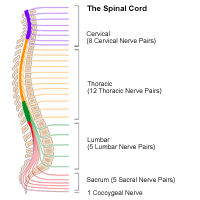Intradiscal Procedures for Back Pain
Intradiscal Procedures for Back Pain
Sometimes back pain comes from the fluid-filled disks that make up your spine.
The spine's 33 bony vertebrae are hooked together in a way that allows the spine to bend and move. In between the 24 vertebra that come in contact with one another is a flat, fluid-filled cushion called a disk. When the disks themselves are causing back pain or pain radiating to the legs, healthcare providers sometimes do an intradiscal procedure It mayease the pain.
Intradiscal procedures are generally considered experimental or investigational. Medical opinion on them varies a lot. Several small studies have said that intradiscal procedures are relatively safe ways to ease back pain. But many experts say they haven't seen much proof that these procedures really work. Some research shows good results for certain procedures. But other research shows less of an effect. For some procedures, more research needs to be done. And the research needs to be done with a larger number of people.
Many intradiscal procedures can be done on an outpatient basis and are slightly invasive. This generally means you will have less pain from the treatment itself and a speedier return to daily life. But before having such a procedure, you'll want to talk with your healthcare provider about the risks and benefits in detail. The healing process may limit your movements. So be sure you understand what you can and can't do after a procedure. Also check to see whether your insurance company covers the procedure you're thinking about.
Types of intradiscal procedures
Percutaneous mechanical disk decompression
During this procedure, your surgeon removes some of the tissue from the center of the bulging disk that is causing you pain. The goal is to remove as little material as possible. In this way, the disk stays stable. The surgeon uses a needle to reach the disk and remove the extra material from the gelatinous center of the disk. This is known as the nucleus pulposus. It is usually done under local anesthesia in a healthcare provider's office. Your movement may be limited for a while after the procedure. But healing is faster than with an open surgery.
Percutaneous thermal intradiscal procedures (TIPs)
This includes treatments such as intradiscal electrotherapy or electrothermal therapy.
For this treatment, the healthcare provider inserts a wire electrode near the disk. Electric current generates heat in the wire. The heat shrinks the disk to ease pain. This procedure is often not covered by insurance.
Laser disk decompression
Another treatment takes some of the fluid out of the disk that is causing pain. Laser treatments have been used to deflate a disk. The healthcare provider inserts an optical fiber into the disk. The heat created causes a small amount of the water content in the center of the disk to turn into vapor. The heat may reduce pain by affecting the chemical structure and decreasing the pressure in the disk.
Risks of the procedures
Like any surgery, these procedures carry some risks:
-
Infection
-
Damage to the disk
-
Damage to nearby tissues and nerves
-
Failure to resolve pain
-
Need for further surgery
Alternative approaches
The first-line treatment for degenerative disk disease is conservative care. This may mean taking anti-inflammatory medicines or other pain medicines and trying physical therapy, exercise, and behavior modification. Many cases of lower back pain go away on their own with time. Some need more attention.
Updated:
May 16, 2019
Sources:
Percutaneous Lumbar Laser Disc Decompression: A Systematic Review of Current Evidence. Singh, V. Pain Physician. 2009, is. 12, pp. 573-88., Practice Guidelines for Chronic Pain Management. Rosenquist, R. Anesthesiology. 2010, is. 112, ed. 4, pp. s810-33.
Reviewed By:
Joseph Campellone MD,Anne Fetterman RN BSN,Raymond Kent Turley BSN MSN RN
